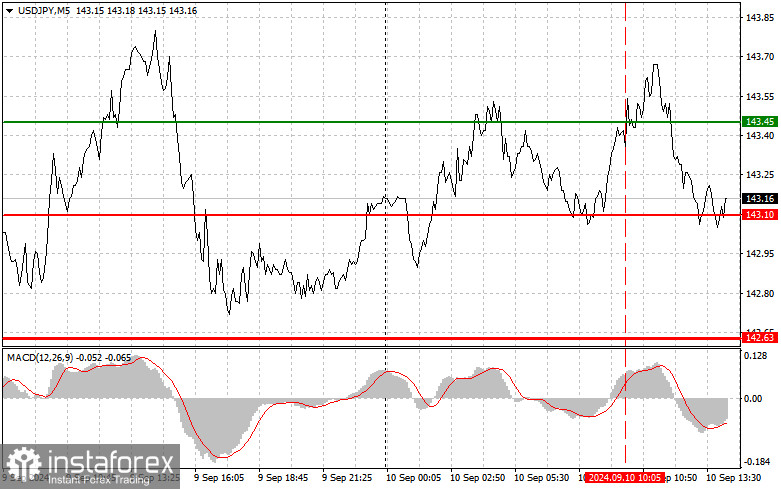Analysis of trades and tips for trading the Japanese yen
The test of the 143.45 level occurred when the MACD indicator had already moved significantly above the zero mark, which limited the dollar's upward potential. For this reason, I did not buy, and I was right. The pair did not see a significant rise, and as the day progressed, pressure on the dollar returned. During the U.S. session, we only expect the NFIB Small Business Optimism Index report, which holds little interest for traders. FOMC member Michael S. Barr's speech will be much more important, and only a hawkish stance might revive demand for the dollar, though this seems unlikely. It's better to continue trading in line with the downward trend for the pair. As for the intraday strategy, I plan to act based on the execution of scenarios #1 and #2.

Buy Signal
Scenario #1: Today, I plan to buy USD/JPY upon reaching the entry point around 143.35 (green line on the chart), targeting a rise to 144.01 (thicker green line on the chart). At 144.01, I will exit the buy trades and open sell trades, targeting a movement of 30-35 points from this level. A rise in the pair can be expected today after strong U.S. data. Important! Before buying, make sure that the MACD indicator is above the zero mark and just starting to rise.
Scenario #2: I also plan to buy USD/JPY today if there are two consecutive tests of the 142.98 level when the MACD is in the oversold area. This will limit the pair's downward risk and lead to a reversal toward higher levels. You can expect growth toward the opposite levels of 143.35 and 144.01.
Sell Signal
Scenario #1: I will sell USD/JPY after it breaks below 142.98 (red line on the chart), which will likely lead to a quick drop in the pair. The key target for sellers will be 142.38, where I will close sell trades and open buy trades, targeting a movement of 20-25 points from this level. Pressure on the pair will return in the case of weak U.S. data. Important! Before selling, make sure that the MACD indicator is below the zero mark and just starting to decline.
Scenario #2: I also plan to sell USD/JPY today if there are two consecutive tests of the 143.35 level when the MACD is in the overbought area. This will limit the pair's upward potential and trigger a market reversal toward lower levels. You can expect a decline toward the opposite levels of 142.98 and 142.38.

What's on the chart:
- Thin green line – entry price for buying the trading instrument.
- Thick green line – estimated price where you can set Take Profit or manually close profits, as further growth above this level is unlikely.
- Thin red line – entry price for selling the trading instrument.
- Thick red line – estimated price where you can set Take Profit or manually close profits, as further decline below this level is unlikely.
- MACD Indicator: When entering the market, it's important to monitor overbought and oversold zones.
Important: Beginner traders in the Forex market must be cautious when making decisions about entering the market. It is best to stay out of the market before major fundamental reports are released to avoid sudden price swings. If you choose to trade during news releases, always set stop-loss orders to minimize losses. Without stop-loss orders, you risk quickly losing your entire deposit, especially if you trade large volumes without proper risk management.
And remember, successful trading requires a clear trading plan, similar to the one presented above. Making spontaneous trading decisions based on the current market situation is inherently a losing strategy for intraday traders.
 English
English 
 Русский
Русский Bahasa Indonesia
Bahasa Indonesia Bahasa Malay
Bahasa Malay ไทย
ไทย Español
Español Deutsch
Deutsch Български
Български Français
Français Tiếng Việt
Tiếng Việt 中文
中文 বাংলা
বাংলা हिन्दी
हिन्दी Čeština
Čeština Українська
Українська Română
Română

